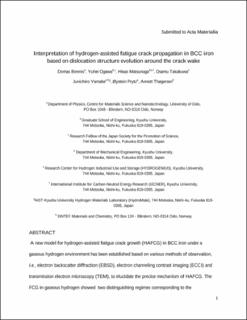| dc.contributor.author | Birenis, Domas | |
| dc.contributor.author | Ogawa, Yuhei | |
| dc.contributor.author | Matsunaga, Hisao | |
| dc.contributor.author | Takakuwa, Osamu | |
| dc.contributor.author | Yamabe, Junichiro | |
| dc.contributor.author | Prytz, Øystein | |
| dc.contributor.author | Thøgersen, Annett | |
| dc.date.accessioned | 2020-12-17T13:00:34Z | |
| dc.date.available | 2020-12-17T13:00:34Z | |
| dc.date.created | 2018-07-25T10:33:48Z | |
| dc.date.issued | 2018 | |
| dc.identifier.citation | Acta Materialia. 2018, 156 245-253. | en_US |
| dc.identifier.issn | 1359-6454 | |
| dc.identifier.uri | https://hdl.handle.net/11250/2720063 | |
| dc.description.abstract | A new model for hydrogen-assisted fatigue crack growth (HAFCG) in BCC iron under a gaseous hydrogen environment has been established based on various methods of observation, i.e., electron backscatter diffraction (EBSD), electron channeling contrast imaging (ECCI) and transmission electron microscopy (TEM), to elucidate the precise mechanism of HAFCG. The FCG in gaseous hydrogen showed two distinguishing regimes corresponding to the unaccelerated regime at a relatively low stress intensity factor range, ΔK, and the accelerated regime at a relatively high ΔK. The fracture surface in the unaccelerated regime was covered by ductile transgranular and intergranular features, while mainly quasi-cleavage features were observed in the accelerated regime. The EBSD and ECCI results demonstrated considerably lower amounts of plastic deformation, i.e., less plasticity, around the crack path in the accelerated regime. The TEM results confirmed that the dislocation structure immediately beneath the crack in the accelerated regime showed significantly lower development and that the fracture surface in the quasi-cleavage regions was parallel to the {100} plane. These observations suggest that the HAFCG in pure iron may be attributed to “less plasticity” rather than “localized plasticity” around the crack tip. | en_US |
| dc.language.iso | eng | en_US |
| dc.publisher | Elsevier | en_US |
| dc.rights | Attribution-NonCommercial-NoDerivatives 4.0 Internasjonal | * |
| dc.rights.uri | http://creativecommons.org/licenses/by-nc-nd/4.0/deed.no | * |
| dc.subject | Transmission electron microscopy (TEM) | en_US |
| dc.subject | Electron back-scattered diffraction (EBSD) | en_US |
| dc.subject | Dislocation structures | en_US |
| dc.subject | Hydrogen embrittlement | en_US |
| dc.subject | Fatigue | en_US |
| dc.title | Interpretation of hydrogen-assisted fatigue crack propagation in BCC iron based on dislocation structure evolution around the crack wake | en_US |
| dc.type | Peer reviewed | en_US |
| dc.type | Journal article | en_US |
| dc.description.version | acceptedVersion | en_US |
| dc.rights.holder | This is the peer-reviewed, accepted manuscript of the article available at ScienceDirect: https://doi.org/10.1016/j.actamat.2018.06.041 | en_US |
| dc.source.pagenumber | 245-253 | en_US |
| dc.source.volume | 156 | en_US |
| dc.source.journal | Acta Materialia | en_US |
| dc.identifier.doi | 10.1016/j.actamat.2018.06.041 | |
| dc.identifier.cristin | 1598567 | |
| dc.relation.project | NORTEM: 197405 | en_US |
| cristin.unitcode | 7401,80,0,0 | |
| cristin.unitname | SINTEF Industri | |
| cristin.ispublished | true | |
| cristin.fulltext | postprint | |
| cristin.qualitycode | 2 | |

